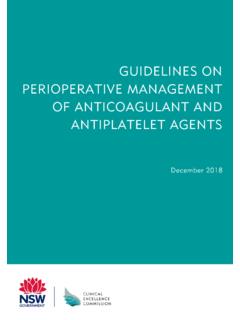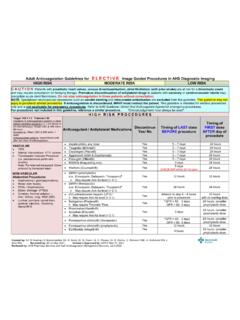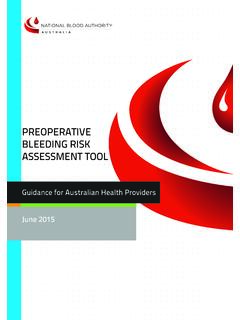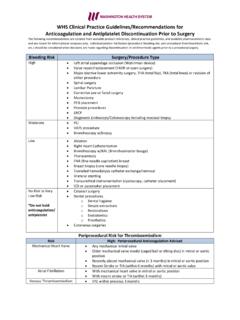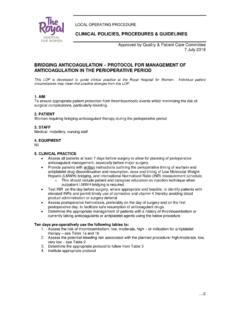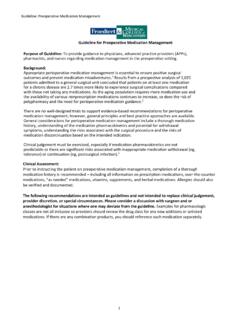Transcription of Perioperative Anticoagulation Algorithm
1 SCHS Anticoagulation Guidelines 1 Perioperative Anticoagulation GUIDELINE/DOAC management Options for Anticoagulation continue to expand with the use of direct oral anticoagulants (DOACs). While the thromboembolic risk is determined by the patient s condition, the Perioperative management of DOACs is vastly different and varied. Bridging is not recommended with DOACs. DOAC Patient is Taking Surgery Bleeding Risk Preoperative DOAC Interruption Schedule Postoperative DOAC Resumption Schedule Day -5 Day -4 Day -3 Day -2 Day -1 Day +1 Day + 2 Day +3 Day +4 Apixaban (Eliquis) Mod/High X X X Low X Dabigatran (CrCl>50ml/min) Mod/High X X X Low X Dabigatran (CrCl<50ml/min) Mod/High X X X X X Low X X Rivaroxaban (Xarelto)
2 Mod/High X X X Low X For patients undergoing neuraxial anesthesia, hold DOAC 72 hours prior to procedure. X denotes patient to Hold DOAC Open arrow segment refers to flexibility in the timing of DOAC resumption post-surgery procedure to account for surgical hemostasis. For patients at low bleeding risk, DOAC was resumed within 24 hours post procedure and for patients at high bleeding risk DOAC was resumed 48-72 hours post procedure. See Appendix A for bleeding risk SCHS Anticoagulation Guidelines 2 Perioperative Anticoagulation GUIDELINE/ WARFARIN management management of Anticoagulation before and after invasive procedures requires careful, patient-specific evaluation of the risk of bleeding weighed against the patient s risk of thromboembolism.
3 The patient s underlying disease process determines the thromboembolic risk. This patient specific risk determines the need for bridging Anticoagulation therapy. Coordination between primary care, Anticoagulation clinic, surgeon, anesthesiologist and when indicated, a specialist, is recommended. This updated guideline is based on extensive literature review and examination of clinical practice guidelines including American College of Chest Physicians 2012 Clinical Practice Guidelines, 2017 ACC Expert Consensus Decision Pathway for Perioprocedural management of Anticoagulation in patients with Nonvalvular Atrial Fibrillation (see reference).
4 Section 1 addresses patients on warfarin and we suggest a 3 step process as outlined below. Steps 1-2 are preoperative. Step 3 is postoperative. Step 1: Determine if Anticoagulation is indicated (review reason for ongoing antithrombotic therapy). Determine if Anticoagulation can be continued without interruption (warfarin or DOACs) Consider bleeding risk of the procedure. For low bleeding risk procedures Anticoagulation can be continued without interruption. Procedures that can be performed on anticoagulants* Ophthalmic Dental Dermatologic Gastrointestinal Cataract surgery Trabeculectomy Restorations Uncomplicated extractions Endodontics Prosthetics Periodontal therapy Dental hygiene Mohs surgery Simple excisions Diagnostic esophagogastroduodenoscopy Colonoscopy without biopsy Diagnostic endoscopic retrograde cholangiopancreatography Biliary stent without sphincterotomy Endoscopic ultrasonography without biopsy Push enteroscopy Jaffer AK.
5 Perioperative management of Warfarin and antiplatelet Therapy, Cleveland Clinic Journal of Medicine, Vol 76, Suppl 4, Nov 2009. *refer to Appendix A for more extensive list SCHS Anticoagulation Guidelines 3 Step 2: When chronic Anticoagulation will be interrupted, determine preoperative thromboembolic risk to decide if preoperative bridging is indicated. Consider the bleeding risk of the procedure when making the decision to implement bridging. If the procedure is a high bleeding risk procedure such as select neurosurgical and urologic procedures seek expert consultation (see Appendix A and B).
6 MODERATE TO HIGH Preop Thrombotic Risk: Consider Bridging LOW Preop Thrombotic Risk: Bridging Not Required Mechanical Heart Valves All mitral valve prosthesis Older mechanical aortic valve prosthesis (caged ball/tilting disk) Stroke/TIA Bi-leaflet aortic valve prosthesis and history of stroke Two or more mechanical valves Bi-leaflet aortic valve prosthesis without stroke On-X Valve without history of stroke Atrial Fibrillation (A fib) Prior embolic stroke confirmed TIA within 1 year Moderate to severe mitral stenosis Cardiac thrombus within 3 months Hypertrophic cardiomyopathy no prior stroke or TIA >1 year ago no moderate to high thrombotic risk conditions Venous Thromboembolism (VTE)
7 Recent VTE within 3 months1 Prior VTE with highly prothrombotic state2 VTE more than 3 months ago no other risk factors Nonsevere thrombophilic conditions, including hereditary disorders Bridging Check INR 7 days prior to surgery Last dose of warfarin 6 days prior to procedure (for INR 2-3, if INR , last dose warfarin 7 days prior) If CrCl>30, initiate enoxaparin* 1 mg/kg SQ 36 hrs after last warfarin dose and continue q12 hrs If CrCl<30, initiate enoxaparin* 1 m/kg SQ 36 hrs after last warfarin dose and continue dose SQ LMWH 1mg/kg 24 hours prior to procedure Alternate dose: SQ q24 hrs, last dose give half the total dose 24 hours prior to surgery Check INR in the morning on the day of surgery No Bridging Check INR 5-7 days prior to surgery Last dose of warfarin 6 days prior to procedure for INR<3.
8 If INR : Last dose of warfarin 7 days prior to procedure Check INR the morning of the procedure *Refer to page 4 for alternative drugs for bridging and contraindications to enoxaparin 1 Delay elective surgery until 3 months post VTE event if possible 2 Triple positive antiphospholipid syndrome, myeloproliferative neoplasm, paroxysmal nocturnal hemoglobinuria, active cancer SCHS Anticoagulation Guidelines 4 Post-Operative Anticoagulation Guideline Step 3.
9 Resume Anticoagulation See appendix A for extensive list of procedures Moderate Bleeding Risk Procedure High Bleeding Risk Procedure Major intrathoracic surgery Major orthopedic surgery Major intraabdominal surgery Pacemaker insertion Hernia Laparoscopic cholecystectomy Endoscopy with biopsy CT or US guided biopsy Coronary artery bypass Cardiac valve replacement Major vascular surgery Neurosurgical procedure Major cancer surgery Prostatectomy or bladder surgery Renal biopsy, bowel polypectomy Low risk of post op thrombosis Bileaflet Aortic Valve without stroke On-X valve Atrial fibrillation and no risks factors3 Resume warfarin 12-24 hours post procedure at usual dose (no bridging therapy) once hemostasis achieved Resume warfarin 3-7 days post procedure at usual dose (No bridging therapy)
10 Moderate risk of post op thrombosis VTE greater than 3 months ago Atrial fibrillation with additional risks factors4 Start prophylactic dose LMWH, post-op day one Resume warfarin 12-24 hours post procedure at usual dose Stop LMWH when reach target INR5 Consider starting prophylactic dose LMWH post-op when hemostasis achieved Resume Warfarin at usual dose once hemostasis achieved Stop LMWH when reach target INR High risk of post op thrombosis Mechanical mitral valve Older mechanical aortic valve Bileaflet aortic valve.
